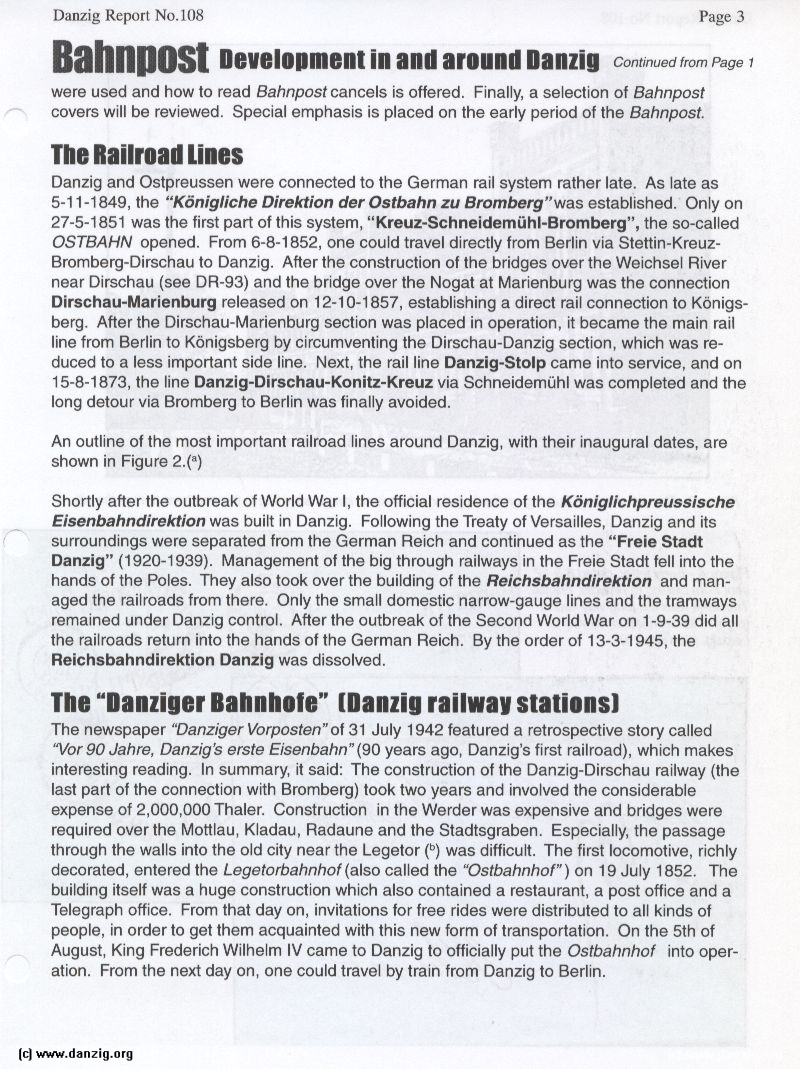
Bahnpost Development in and around Danzig
were used and how to read Bahnpost cancels is offered. Finally, a selection of Bahnpost covers will be reviewed. Special emphasis is placed on the early period of the Bahnpost.
The Railroad Lines
Danzig and Ostpreussen were connected to the German rail system rather late. As late as 5-11-1849. the “Könlgliche Direktion der Ostbahn zu Bromberg” was established. Only on 27-5-1851 was the first part of this system, ‘Kreuz-SchneidemUhl-Bromberg”, the so-called OSTBAHN opened. From 6-8-1852, one could travel directly from Berlin via Stettin-KreuzB romberg-Dirschau to Danzig. After the construction of the bridges over the Weichsel River near Dirschau (see DR-93) and the bridge over the Nogat at Marienburg was the connection Dlrschau-Martenburg released on 12-10-1857, establishing a direct rail connection to Königsb erg. After the Dirschau-Marienburg section was placed in operation, it became the main rail line from Berlin to Kanigsberg by circumventing the Dirschau-Danzig section, which was red uced to a less important side line. Next, the rail line Danzlg-Stolp came into service, and on 15-8-1873, the line Danzig-Dirschau-Konitz-Kreuz via Schneidemühl was completed and the long detour via Bromberg to Berlin was finally avoided.
An outline of the most important railroad lines around Danzig, with their inaugural dates, are shown in Figure 2.(e)
Shortly after the outbreak of World War I, the official residence of the Könlglichpreusslsche Elsenbahndirektlon was built in Danzig. Following the Treaty of Versailles, Danzig and its surroundings were separated from the German Reich and continued as the “Frele Stadt Danzig” (1920-1939). Management of the big through railways in the Freie Stadt fell into the hands of the Poles. They also took over the building of the Reichsbahndirektion and mana ged the railroads from there. Only the small domestic narrow-gauge lines and the tramways remained under Danzig control. After the outbreak of the Second World War on 1-9-39 did all the railroads return into the hands of the German Reich. By the order of 13-3-1945, the Reichsbahndirektion Danzig was dissolved.
Tile “Danziger Bahnhofe” [Danzig railway stations]
The newspaper “Oanziger Vorposton”of 31 July 1942 featured a retrospective story called I/or 90 Jahre, Danzig’s erste Eisenbahri(90 years ago, Danzig’s first railroad), which makes interesting reading. In summary, it said: The construction of the Danzig-Dirschau railway (the last part of the connection with Bromberg) took two years and involved the considerable expense of 2,000,000 Thaler. Construction in the Werder was expensive and bridges were required over the Mottlau, Kladau, Radaune and the Stadtsgraben. Especially, the passage through the walls into the old city near the Legetor (“) was difficult. The first locomotive, richly decorated, entered the Legetorbahnhof (also called the “Ostbahnhof”) on 19 July 1852. The building itself was a huge construction which also contained a restaurant, a post office and a Telegraph office. From that day on, invitations for free rides were distributed to all kinds of people, in order to get them acquainted with this new form of transportation. On the 5th of August, King Frederich Wilhelm IV came to Danzig to officially put the Ostbahnhof into opera tion. From the next day on, one could travel by train from Danzig to Berlin.
Danzig Report Vol. 1 - Nr. 108 - July - August - September - 2000, Page 3.
Hits: 4622
Added: 28/07/2015
Copyright: 2025 Danzig.org

